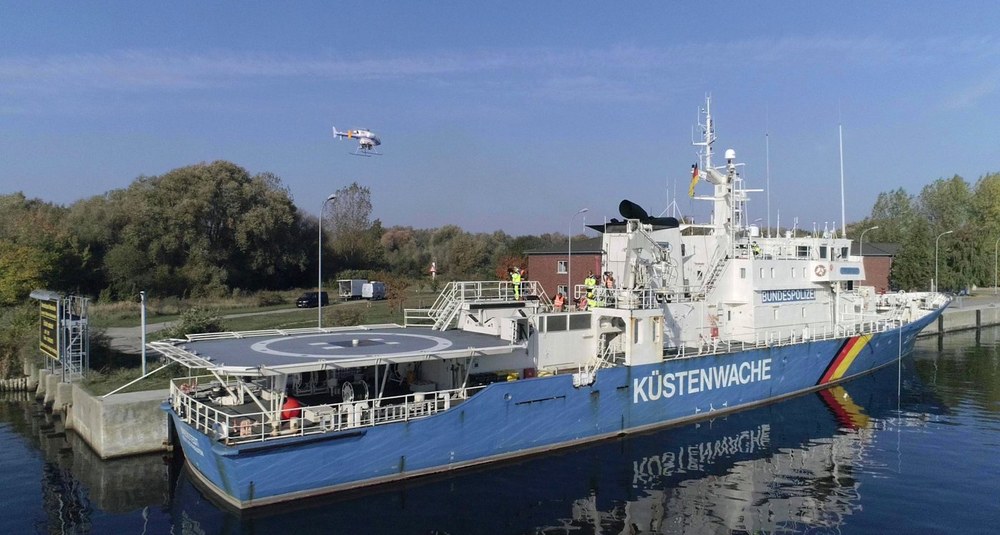MaRPAS 3

In the maritime area of operation of the German Federal Police, the ship-based operation of unmanned aerial vehicles (Remotely Piloted Aircraft System, RPAS) to record highly automated situation images and to recognise safety-critical situations would help to be able to react quickly in the event of a need for deployment. Within the framework of the MaRPAS 3 (Maritime RPAS Operation 3) project, this possible application is being further researched.
Project description
The DLR project MaRPAS 3 is an element of the overall project “R&D for Maritime Safety and Security and Dedicated Real-Time Services” (EMS-IV) within the DLR Research Cluster for Maritime Safety and Security. As in the previous projects MaRPAS and MaRPAS 2, the Institute of Flight Guidance (FL) and the Institute of Flight Systems (FT) are working together with the Bundespolizei See (German maritime police, BPOL).
One goal of the project is a Concept of Operations for the utilisation of RPAS by the BPOL. Although the previous projects laid the foundations for this, the legal framework conditions have changed since then, in particular as regards the operation of RPAS at sea in Europe. A new aspect of the research in MaRPAS 3 is the integration of RPAS operations into the everyday operations of the BPOL at sea.
Rope-guided ship-deck landing
In the previous projects, work was carried out on a procedure for landing a drone on a ship with the help of a guiding rope. This procedure is particularly relevant in severe weather conditions and will be further researched within MaRPAS 3 in order to increase the degree of maturity of the technology. The winch used under the drone offers other application possibilities. As an application case, investigations will be undertaken to determine how the winch can be used to measure the exhaust gases in the exhaust plume of a target vessel. In this case, the advantage of the winch is that the measurement can be carried out at a considerable distance from the aircraft, thereby reducing the influence of the aircraft, such as the downdraft from the rotor blades. This could help the BPOL to fulfil its mission to protect the maritime ecosystem and the climate in accordance with the applicable laws.
Ground control station and guidance of the drone
In order to effectively conduct an operation at sea, a corresponding ground control station is required on board the operational vessel. In MaRPAS 3, a corresponding display concept is to be developed at the ground control station for BPOL operations. For this purpose, the processes and procedures of the BPOL's work during operations are to be investigated in order to provide the drone operator with precisely the right data for the operation. The Institute of Flight Guidance will therefore further develop its existing ground control station accordingly.
In addition, the systems for guiding the drone must also be further developed. The ground control station utilises models of the drone's flight behaviour for mission planning. These models depend on exact flight-mechanical parameters of the deployed drones; in contrast to manned aviation, however, these parameters are not available for each individual drone. A method is therefore to be developed that learns from the observation of a drone's flight behaviour in order to predict its future flight behaviour. A procedure had already been developed within MaRPAS 2 which enables a drone to track a target ship, i.e. to position the drone relative to the target in accordance with the mission requirements. This procedure is to be implemented and tested within MaRPAS 3. For a landing of the drone under moderate weather conditions, guidance via a rope is not necessary. The procedure for guiding the drone relative to the mother ship is therefore to be further developed in such a way that the drone can land safely on the flight deck.
New drones
A decision has not yet been made as to which type of drone the BPOL would like to procure for its operations. The previous research within MaRPAS and MaRPAS 2 was conducted using a helicopter drone. A helicopter drone offers a number of unique advantages, most notably the ability to maintain a position relative to a target. This is, however, offset by the poor flight performance compared to a fixed-wing aircraft. Due to its aerodynamic efficiency, a fixed-wing aircraft has a significantly greater range, endurance and speed than a helicopter. In MaRPAS 3, a Maritime Robotics PX-31 drone will therefore be deployed to investigate the application possibilities of a fixed-wing drone for the BPOL.
Training the crew
The crew of the BPOL must also be prepared for RPAS operation. DLR will therefore develop training procedures in order to optimally prepare the crews for the operation. This will be performed on the basis of the investigations concerning the integration of RPAS deployment into ship operations.
Project | MaRPAS 3 (Maritimer RPAS-Betrieb 3) |
Participants | DLR Institute of Flight Guidance DLR Institute of Flight Systems (coordinator) Bundespolizei See (German maritime police) |
Duration | 2022 – 2024 |
Funding | Institutional funding |
